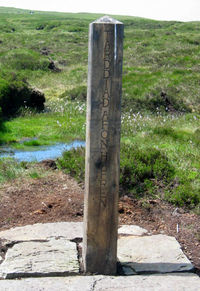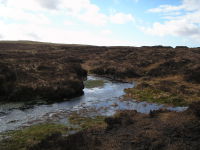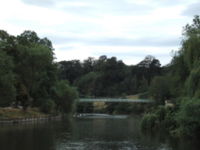River Severn
2007 Schools Wikipedia Selection. Related subjects: Geography of Great Britain
| River Severn | |
|---|---|
|
|
|
| Origin | Plynlimon, Wales |
| Mouth | Bristol Channel |
| Basin countries | United Kingdom (England, Wales) |
| Length | 354 km (219 mi) |
| Source elevation | 524 m (1,719 ft) |
| Mouth elevation | 0 m (0 ft) |
| Avg. discharge | 107 m³/s |
| Basin area | 11,420 km² (7,096 mi²) |
The River Severn ( Welsh: Afon Hafren) is the longest British river, at 354 kilometres (219 miles) long ; it rises at an altitude of 610 metres on Plynlimon near Llanidloes, in the Cambrian Mountains, Mid Wales, and it passes through a number of English counties, with the county towns of Shrewsbury, Worcester, and Gloucester located on its banks. The Severn becomes the Bristol Channel at its estuary, eventually discharging into the celtic Sea and the Atlantic Ocean. With an average discharge of 107 m³/s at Hawbridge ( Gloucestershire), the Severn is England's largest river in terms of water flow. The Severn's drainage basin area is 11,420 km². It is one of the ten major rivers in the United Kingdom.


Mythology
According to some sources, the name "Severn" is derived from the name Sabrina or ( Hafren), based on the mythical story of the drowning of a nymph in the river. Sabrina is also the goddess of the River Severn in Brythonic mythology. The story of Sabrina is featured in Milton's Comus. There is a statue of 'Sabrina' in the Dingle Gardens at the Quarry, Shrewsbury.
As the Severn becomes tidal the associated deity changes to Noadu, who (Romanized as Nodens) is represented mounted on a seahorse, riding on the crest of the Severn bore.
Tributary rivers
The River Stour rises in the north of Worcestershire in the Clent Hills, near St Kenelm's Church at Frankley. It flows north into the adjacent West Midlands at Halesowen. It then flows westwards through Cradley Heath and Stourbridge where it leaves the Black Country. It is joined by the Smestow Brook at Prestwood before it winds around southwards to Kinver, and then flows back into Worcestershire. It then passes through Wolverley, Kidderminster and Wilden to join the Severn at Stourport-on-Severn.
A tributary of the Severn, called the River Teme, joins it just below Worcester and above Kempsey.
One of the several rivers named Avon joins the Severn at Tewkesbury, Gloucestershire. That same Avon also flows through Stratford-upon-Avon.
The port of Bristol is located at the mouth of the Severn, where another River Avon flows into it. The River Wye flows into the Severn slightly upstream of the Avon and forms the boundary between England, specifically the Forest of Dean, and Wales, with the town of Chepstow (Casgwent in Welsh) at the confluence, giving an important strategic position in yester-year and was the main route into South Wales, before the two bridges were built.
Transport
Bridges
The two bridges of the Severn crossing carrying roads (opened in 1966 and 1996) link Wales with the southern counties of England and are among the most important in Britain. The Severn is bridged at many places, and many of these bridges are notable in their own right, with several designed and built by the engineer Thomas Telford. (See List of Severn bridges for more.) There also is the very famous Ironbridge at Coalbrookdale, which is the first ever Iron Bridge in the world.
Disasters
There have been many disasters on the Severn, making it Britain's most dangerous river. It has claimed many lives, especially during the 20th century.
Locks
There are locks on the lower Severn to enable sea going boats as far as Stourport. The most northerly lock is at Lincombe about a mile downstream from Stourport.
Tunnels
The Severn Tunnel carries the Great Western Main Line under the large estuary.
Associated canals
The Staffordshire and Worcestershire Canal, the Worcester and Birmingham Canal, and the Herefordshire and Gloucestershire Canal all join the Severn at Stourport, Worcester and Gloucester respectively. The Droitwich Barge Canal used to join the Severn at Hawford, near to the River Salwarpe and it hoped that a new link to the Severn via the Salwarpe will be re-established in the future.
Paddle Steamers
The main operator of pleasure craft and particularly Paddle Steamers on the river from the mid-1800's to the late 1970's were P and A Campbell of Bristol, but also included the Barry Railway Company. There were also three ferries operating between Aust and Chepstow these were called the Severn King, Severn Queen and Severn Princess. The Severn Princess is currently undergoing restoration after being found in Ireland full of fertiliser, after dragging her back with her sinking twice on the way it is hoped that at some time in the near future she will be fully operational again. The Severn King and Queen were scrapped not long after their decommmision following the completion of the First Severn Bridge.
Tidal bore
A curious phenomenon associated with the lower reaches of the Severn is the tidal phenomenon known as the bore. The bore forms somewhat upstream of the Port of Sharpness, which is also the Southern terminus of the Gloucester and Sharpness Canal.
The river's estuary, part of the Bristol Channel, has the second largest tidal range in the world — about 15 metres, exceeded only by the Bay of Fundy in Canada — and at spring tides, the rising water is funnelled up the estuary into a wave that travels rapidly upstream against the river current; enthusiasts even attempt to surf along on the wave, which can be 2 m high. In 2006, a world record surf was achieved, for the longest-ever 'surf', by Steve King, a railway engineer from Gloucestershire, England. (Note that the Gloucester Harbour Trustees, as competent harbour authority for this part of the river, explicitly advise against this pastime.) Being the onset of the flood tide it is accompanied by a rapid rise in water level which continues for about one and a half hours after the bore has passed. The Severn Bore is a natural example of a self-reinforcing solitary wave or soliton.
Tidal Power
The huge tidal range (15m) and high level of surrounding industry and population have long made the Severn estuary a focus for tidal energy schemes and ideas. Plans for a Severn Barrage - running 16 km (10 miles) from Lavernock Point near to and south west of Cardiff to Brean Down near and just south west of Weston Super Mare in Somerset - would generate a massive 8640 MW when the tide flows, and have been discussed for several decades now. The power generated, coming from a lake of 185 square miles and 14 m potential energy depth, would be equivalent to 12 nuclear power stations. Tidal power only runs for some 10 hours a day, but by using the enclosed lake as a reservoir of potential energy more hours of operation could be achieved. Other energy sources, such as wind and solar power, also create electricity at times that do not always match when it is needed. Excess power could be stored by pumping water uphill, as is already done at a variety of other installations in the UK.
The UK Government shelved the plans in the late 1980s due largely to cost issues and local environmental concerns. However, this was before recent huge rises in the price of energy, and before Global Warming had started to be taken seriously. As of 2006 the idea has been revitalised and now looks likely to be implemented.
Because global warming and nuclear power station waste and decomissioning have such vast environmental effects, the small environmental impact of the Severn Barrage is an overall reduction in impact. Further work is required to decrease the environmental impact of the project.
Industry
A six-mile stretch of the Severn valley in Shropshire, known as the Ironbridge Gorge, was designated a World Heritage Site by UNESCO in 1986. Its historic importance is due to its role as the centre of the iron industry in the early stages of Britain's Industrial Revolution. Ironbridge gets its name from the bridge across the Severn, built in 1779, which was the first cast-iron bridge ever constructed.
Wildlife
The sides of the estuary are also important feeding grounds for waders, notably at the Bridgwater Bay National Nature Reserve and the Slimbridge Wildfowl Trust.


